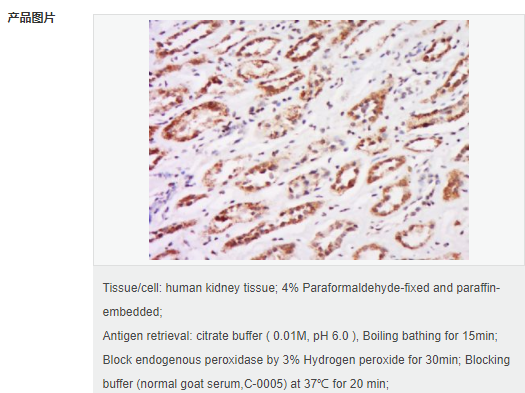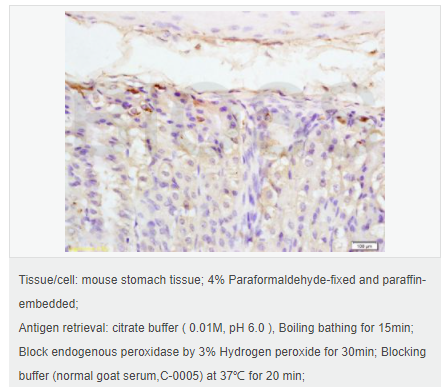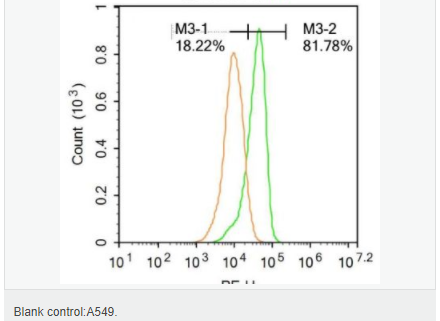

貨號
產(chǎn)品規(guī)格
售價
備注
BN41654R-50ul
50ul
¥1486.00
交叉反應(yīng):Human,Mouse(predicted:Rat,Dog,Pig,Cow,Horse,Rabbit,Sheep) 推薦應(yīng)用:IHC-P,IHC-F,IF,Flow-Cyt,ELISA
BN41654R-100ul
100ul
¥2360.00
交叉反應(yīng):Human,Mouse(predicted:Rat,Dog,Pig,Cow,Horse,Rabbit,Sheep) 推薦應(yīng)用:IHC-P,IHC-F,IF,Flow-Cyt,ELISA
BN41654R-200ul
200ul
¥3490.00
交叉反應(yīng):Human,Mouse(predicted:Rat,Dog,Pig,Cow,Horse,Rabbit,Sheep) 推薦應(yīng)用:IHC-P,IHC-F,IF,Flow-Cyt,ELISA
產(chǎn)品描述
| 英文名稱 | PTHLH |
| 中文名稱 | 甲狀旁腺激素相關(guān)蛋白抗體 |
| 別 名 | Parathyroid Hormone Related Protein; Parathyroid Hormone-related Protein; HHM; MGC14611; Osteostatin; Parathyroid hormon like hormone isoform 2 preproprotein; Parathyroid hormone like hormone; Parathyroid hormone like hormone isoform 1 preproprotein; Parathyroid hormone like protein; Parathyroid hormone like related protein; Parathyroid Hormone Receptor 1; Parathyroid like protein; PLP; PTH related protein; PTH rP; PTHrP; PTHR; PTHRP. |
| 研究領(lǐng)域 | 免疫學 生長因子和激素 內(nèi)分泌病 |
| 抗體來源 | Rabbit |
| 克隆類型 | Polyclonal |
| 交叉反應(yīng) | Human, Mouse, (predicted: Rat, Dog, Pig, Cow, Horse, Rabbit, Sheep, ) |
| 產(chǎn)品應(yīng)用 | ELISA=1:5000-10000 IHC-P=1:100-500 IHC-F=1:100-500 Flow-Cyt=1ug/test IF=1:100-500 (石蠟切片需做抗原修復(fù)) not yet tested in other applications. optimal dilutions/concentrations should be determined by the end user. |
| 分 子 量 | 16kDa |
| 細胞定位 | 細胞核 細胞漿 分泌型蛋白 |
| 性 狀 | Liquid |
| 濃 度 | 1mg/ml |
| 免 疫 原 | KLH conjugated synthetic peptide derived from human PTHrP:101-177/177 |
| 亞 型 | IgG |
| 純化方法 | affinity purified by Protein A |
| 儲 存 液 | 0.01M TBS(pH7.4) with 1% BSA, 0.03% Proclin300 and 50% Glycerol. |
| 保存條件 | Shipped at 4℃. Store at -20 °C for one year. Avoid repeated freeze/thaw cycles. |
| PubMed | PubMed |
| 產(chǎn)品介紹 | Parathyroid related protein (PTHLH), is a polypeptide hormone produced by almost every tissue of the body and is closely related to parathyroid hormone (PTH). It signals through its receptor, PTHR1, regulating endochondral bone development and epithelial-mesenchymal interactions during the formation of the mammary glands and teeth. The receptor for this hormone (PTHRP) is responsible for most cases of humoral hypercalcemia of malignancy. Function: This is a receptor for parathyroid hormone and for parathyroid hormone-related peptide. The activity of this receptor is mediated by G proteins which activate adenylyl cyclase and also a phosphatidylinositol-calcium second messenger system. Subunit: PTHrP interacts with PTH1R (via N-terminal extracellular domain). Subcellular Location: Cytoplasmic, Nuclear and Secreted Tissue Specificity: Expressed in most tissues. Most abundant in kidney, bone and liver. DISEASE: Defects in PTH1R are the cause of Jansen metaphyseal chondrodysplasia (JMC) [MIM:156400]. JMC is a rare autosomal dominant disorder characterized by a short-limbed dwarfism associated with hypercalcemia and normal or low serum concentrations of the two parathyroid hormones. Defects in PTH1R are the cause of chondrodysplasia Blomstrand type (BOCD) [MIM:215045]. BOCD is a severe skeletal dysplasia. Defects in PTH1R may be a cause of enchondromatosis multiple (ENCHOM) [MIM:166000]. Enchondromas are common benign cartilage tumors of bone. They can occur as solitary lesions or as multiple lesions in enchondromatosis (Ollier and Maffucci diseases). Clinical problems caused by enchondromas include skeletal deformity and the potential for malignant change to osteosarcoma. Similarity: Belongs to the G-protein coupled receptor 2 family. SWISS: P12272 Gene ID: 5744 Database links: Entrez Gene: 5744 Human Entrez Gene: 19227 Mouse Omim: 168470 Human SwissProt: P12272 Human SwissProt: P22858 Mouse SwissProt: Q540C1 Mouse SwissProt: Q811S6 Mouse SwissProt: Q924X4 Mouse Unigene: 89626 Human Unigene: 9750 Rat Important Note: This product as supplied is intended for research use only, not for use in human, therapeutic or diagnostic applications. |



